Page 65 of 382
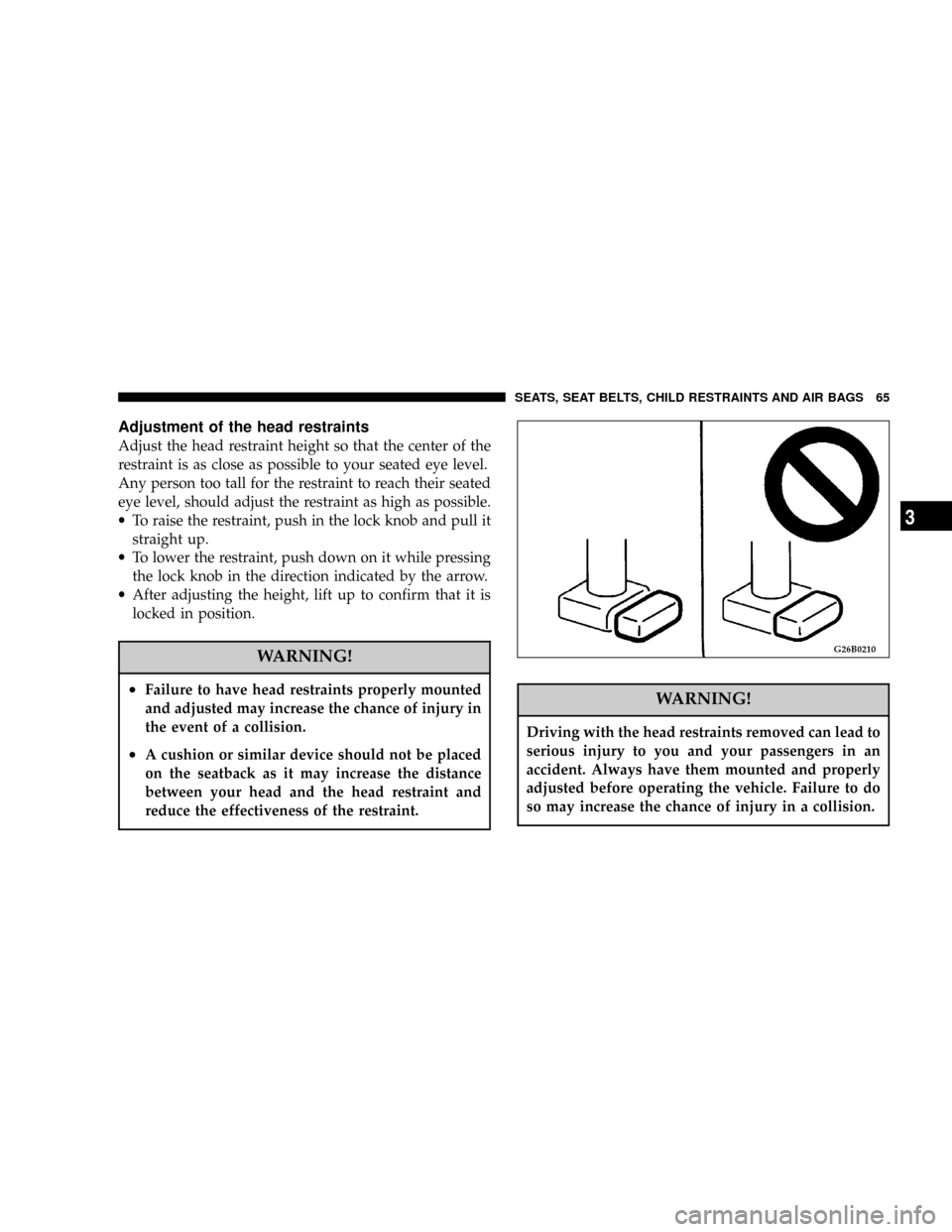
Adjustment of the head restraints
Adjust the head restraint height so that the center of the
restraint is as close as possible to your seated eye level.
Any person too tall for the restraint to reach their seated
eye level, should adjust the restraint as high as possible.
·To raise the restraint, push in the lock knob and pull it
straight up.
·To lower the restraint, push down on it while pressing
the lock knob in the direction indicated by the arrow.
·After adjusting the height, lift up to confirm that it is
locked in position.
WARNING!
²Failure to have head restraints properly mounted
and adjusted may increase the chance of injury in
the event of a collision.
²A cushion or similar device should not be placed
on the seatback as it may increase the distance
between your head and the head restraint and
reduce the effectiveness of the restraint.
WARNING!
Driving with the head restraints removed can lead to
serious injury to you and your passengers in an
accident. Always have them mounted and properly
adjusted before operating the vehicle. Failure to do
so may increase the chance of injury in a collision.
G26B0210
SEATS, SEAT BELTS, CHILD RESTRAINTS AND AIR BAGS 65
3
Page 66 of 382
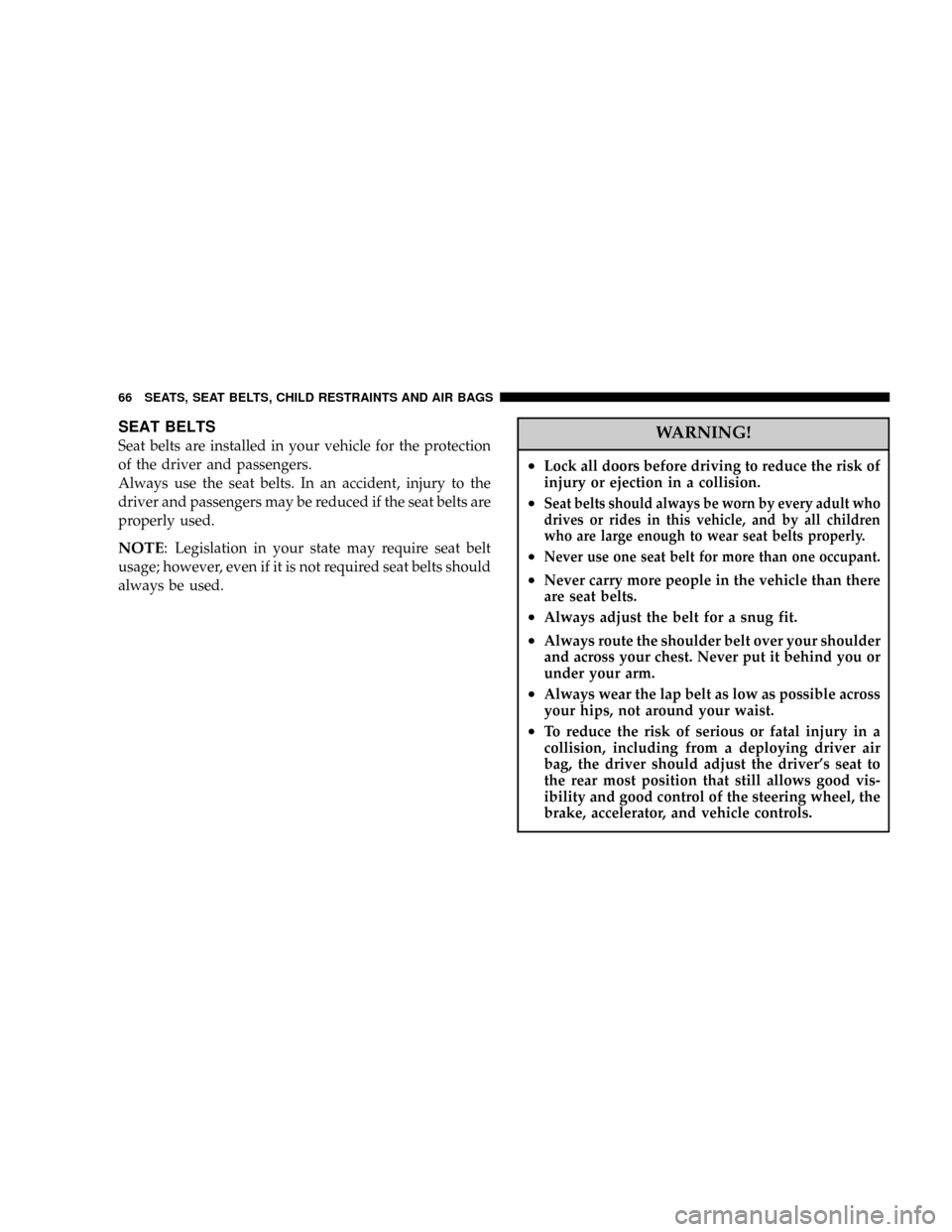
SEAT BELTS
Seat belts are installed in your vehicle for the protection
of the driver and passengers.
Always use the seat belts. In an accident, injury to the
driver and passengers may be reduced if the seat belts are
properly used.
NOTE: Legislation in your state may require seat belt
usage; however, even if it is not required seat belts should
always be used.
WARNING!
²Lock all doors before driving to reduce the risk of
injury or ejection in a collision.
²Seat belts should always be worn by every adult who
drives or rides in this vehicle, and by all children
who are large enough to wear seat belts properly.
²Never use one seat belt for more than one occupant.
²Never carry more people in the vehicle than there
are seat belts.
²Always adjust the belt for a snug fit.
²Always route the shoulder belt over your shoulder
and across your chest. Never put it behind you or
under your arm.
²Always wear the lap belt as low as possible across
your hips, not around your waist.
²To reduce the risk of serious or fatal injury in a
collision, including from a deploying driver air
bag, the driver should adjust the driver's seat to
the rear most position that still allows good vis-
ibility and good control of the steering wheel, the
brake, accelerator, and vehicle controls.
66 SEATS, SEAT BELTS, CHILD RESTRAINTS AND AIR BAGS
Page 67 of 382
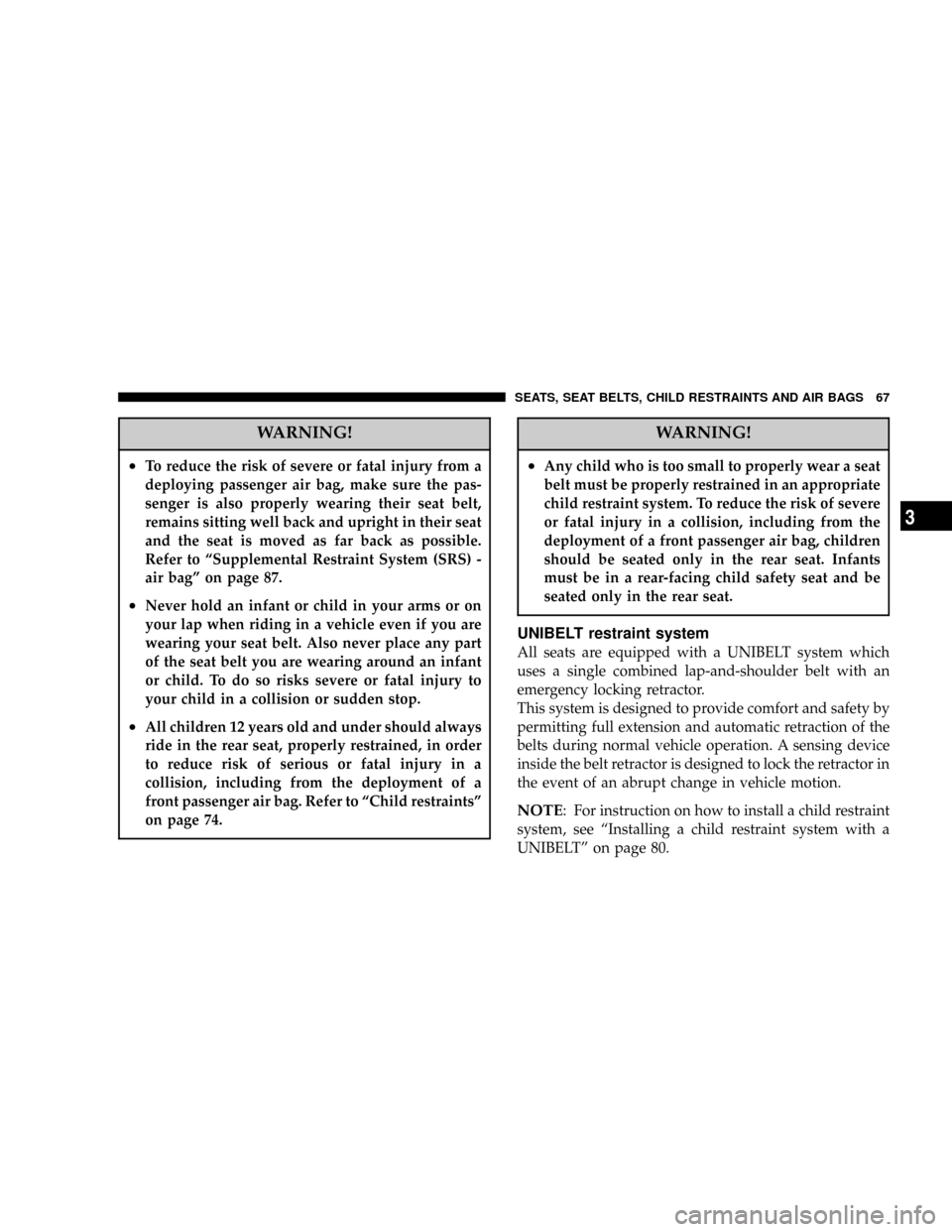
WARNING!
²To reduce the risk of severe or fatal injury from a
deploying passenger air bag, make sure the pas-
senger is also properly wearing their seat belt,
remains sitting well back and upright in their seat
and the seat is moved as far back as possible.
Refer to ªSupplemental Restraint System (SRS) -
air bagº on page 87.
²Never hold an infant or child in your arms or on
your lap when riding in a vehicle even if you are
wearing your seat belt. Also never place any part
of the seat belt you are wearing around an infant
or child. To do so risks severe or fatal injury to
your child in a collision or sudden stop.
²All children 12 years old and under should always
ride in the rear seat, properly restrained, in order
to reduce risk of serious or fatal injury in a
collision, including from the deployment of a
front passenger air bag. Refer to ªChild restraintsº
on page 74.
WARNING!
²Any child who is too small to properly wear a seat
belt must be properly restrained in an appropriate
child restraint system. To reduce the risk of severe
or fatal injury in a collision, including from the
deployment of a front passenger air bag, children
should be seated only in the rear seat. Infants
must be in a rear-facing child safety seat and be
seated only in the rear seat.
UNIBELT restraint system
All seats are equipped with a UNIBELT system which
uses a single combined lap-and-shoulder belt with an
emergency locking retractor.
This system is designed to provide comfort and safety by
permitting full extension and automatic retraction of the
belts during normal vehicle operation. A sensing device
inside the belt retractor is designed to lock the retractor in
the event of an abrupt change in vehicle motion.
NOTE: For instruction on how to install a child restraint
system, see ªInstalling a child restraint system with a
UNIBELTº on page 80.
SEATS, SEAT BELTS, CHILD RESTRAINTS AND AIR BAGS 67
3
Page 69 of 382
2. Grasp the metal tongue and slide it up the webbing so
that it becomes easy to pull across your body.
After a couple of tries this will become an automatic
one-handed motion.3. Pull the seat belt out slowly while holding the metal
tongue. This system will not lock up if you stop or
hesitate, so relax and continue to ªbuckle-upº.
Push the metal tongue into the buckle until a ªclickº is
heard. Pull up on the belt to confirm the metal tongue is
locked securely in the buckle.
NOTE:If the seat belt is pulled to its full extension, it can
enter the ALR mode and lock in position. If this occurs,
allow the belt to fully retract and then repeat step 3.
G28A0220G28A0230
SEATS, SEAT BELTS, CHILD RESTRAINTS AND AIR BAGS 69
3
Page 70 of 382
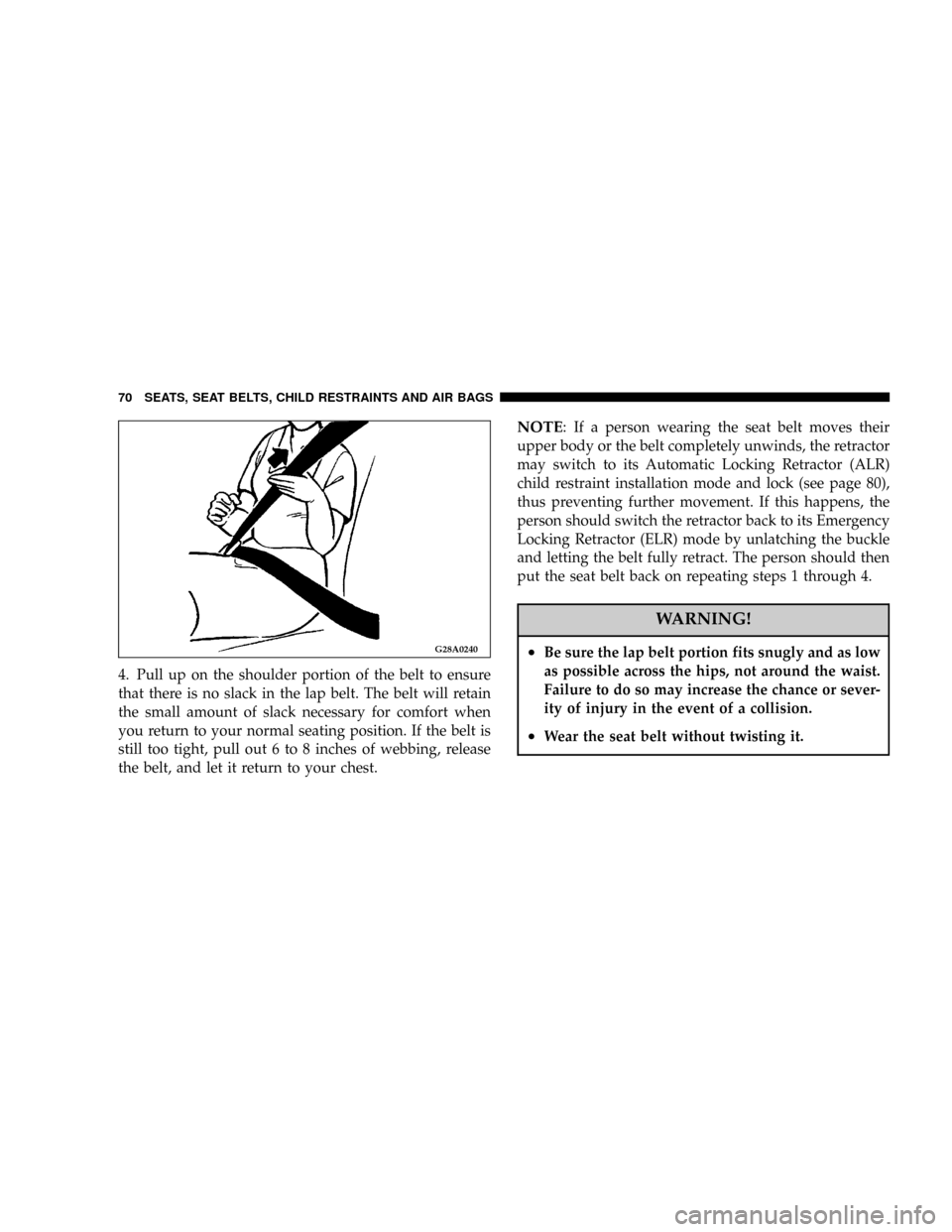
4. Pull up on the shoulder portion of the belt to ensure
that there is no slack in the lap belt. The belt will retain
the small amount of slack necessary for comfort when
you return to your normal seating position. If the belt is
still too tight, pull out 6 to 8 inches of webbing, release
the belt, and let it return to your chest.
NOTE: If a person wearing the seat belt moves their
upper body or the belt completely unwinds, the retractor
may switch to its Automatic Locking Retractor (ALR)
child restraint installation mode and lock (see page 80),
thus preventing further movement. If this happens, the
person should switch the retractor back to its Emergency
Locking Retractor (ELR) mode by unlatching the buckle
and letting the belt fully retract. The person should then
put the seat belt back on repeating steps 1 through 4.
WARNING!
²Be sure the lap belt portion fits snugly and as low
as possible across the hips, not around the waist.
Failure to do so may increase the chance or sever-
ity of injury in the event of a collision.
²Wear the seat belt without twisting it.
G28A0240
70 SEATS, SEAT BELTS, CHILD RESTRAINTS AND AIR BAGS
Page 71 of 382
5. The shoulder belt portion will allow regular move-
ment under normal conditions. The belt will lock in the
event of an abrupt change in vehicle motion.
6. To release the belt, push the button on the buckle. The
belt retracts automatically, so hold the tongue when the
belt is released and while it retracts. Should the belt not
fully return to its stowed position, pull the shoulder belt
down slightly and release quickly.
Adjustable seat belt shoulder anchor (front seats)
The seat belt shoulder anchor height can be adjusted for
greater comfort.
To move the anchor down, depress the lock knob (A). To
move the anchor up, simply slide the anchor up to the
desired position (there is no need to depress the lock
knob).
G28A0260
G08C0070
SEATS, SEAT BELTS, CHILD RESTRAINTS AND AIR BAGS 71
3
Page 74 of 382

WARNING!
²The extender should only be used if the existing
belt is not long enough.
Persons who can use the standard seat belt should
not use an extender. Unnecessary use could result
in serious personal injury in the event of a colli-
sion.
²When not required, the extender must be removed
and stowed because the use of the extender when
not required may deactivate the seat belt locking
mechanism.
CHILD RESTRAINTS
When transporting infants or small children in your
vehicle, an appropriate child restraint system should
always be used. This is required by law in most states.
Child restraints specifically designed for infants and
small children are offered by several manufacturers. Only
choose a child restraint system with a label certifying it
complies with Federal Motor Vehicle Safety Standard
213.The child restraint system should be appropriate for your
child's weight and height and properly fit the vehicle's
seat.
All children should be restrained in a restraint device that
offers the maximum protection for their size and age.
·Children less than 1 year and less than 20 pounds must
ride in a rear-facing child safety seat only in the rear
seat.
·Children older than 1 year who weigh less than 40
pounds or are less than 40 inches tall should be in a
forward-facing restraint in the rear seat.
·Children who weigh more than 40 pounds or are more
than 40 inches tall - regardless of age - should use a
booster seat in the rear seat until the lap/shoulder belt
fits properly.
74 SEATS, SEAT BELTS, CHILD RESTRAINTS AND AIR BAGS
Page 80 of 382
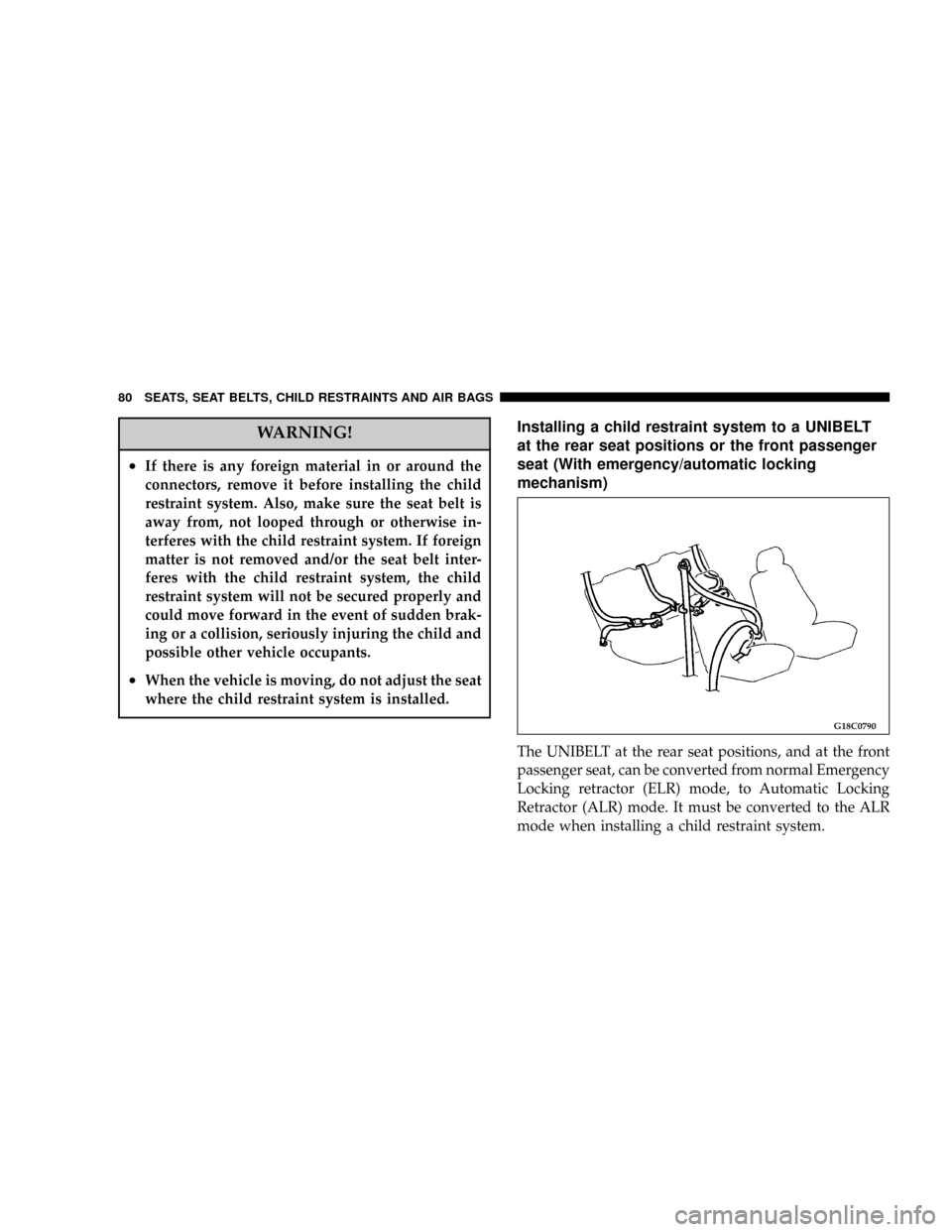
WARNING!
²If there is any foreign material in or around the
connectors, remove it before installing the child
restraint system. Also, make sure the seat belt is
away from, not looped through or otherwise in-
terferes with the child restraint system. If foreign
matter is not removed and/or the seat belt inter-
feres with the child restraint system, the child
restraint system will not be secured properly and
could move forward in the event of sudden brak-
ing or a collision, seriously injuring the child and
possible other vehicle occupants.
²When the vehicle is moving, do not adjust the seat
where the child restraint system is installed.
Installing a child restraint system to a UNIBELT
at the rear seat positions or the front passenger
seat (With emergency/automatic locking
mechanism)
The UNIBELT at the rear seat positions, and at the front
passenger seat, can be converted from normal Emergency
Locking retractor (ELR) mode, to Automatic Locking
Retractor (ALR) mode. It must be converted to the ALR
mode when installing a child restraint system.
G18C0790
80 SEATS, SEAT BELTS, CHILD RESTRAINTS AND AIR BAGS